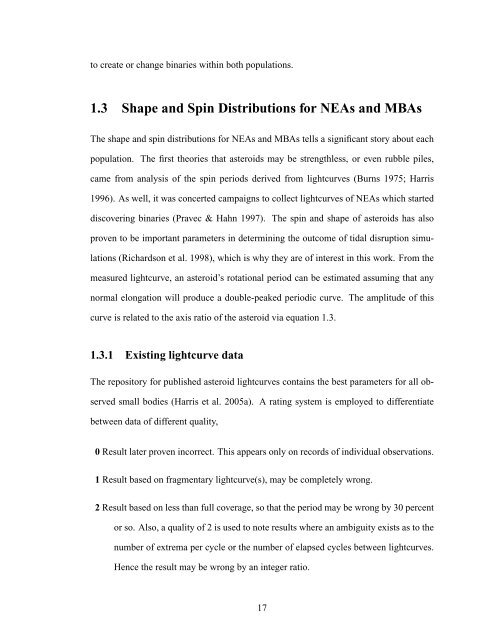Forming Binary Near-Earth Asteroids From Tidal Disruptions
Forming Binary Near-Earth Asteroids From Tidal Disruptions
Forming Binary Near-Earth Asteroids From Tidal Disruptions
You also want an ePaper? Increase the reach of your titles
YUMPU automatically turns print PDFs into web optimized ePapers that Google loves.
to create or change binaries within both populations.1.3 Shape and Spin Distributions for NEAs and MBAsThe shape and spin distributions for NEAs and MBAs tells a significant story about eachpopulation. The first theories that asteroids may be strengthless, or even rubble piles,came from analysis of the spin periods derived from lightcurves (Burns 1975; Harris1996). As well, it was concerted campaigns to collect lightcurves of NEAs which starteddiscovering binaries (Pravec & Hahn 1997). The spin and shape of asteroids has alsoproven to be important parameters in determining the outcome of tidal disruption simulations(Richardson et al. 1998), which is why they are of interest in this work. <strong>From</strong> themeasured lightcurve, an asteroid’s rotational period can be estimated assuming that anynormal elongation will produce a double-peaked periodic curve. The amplitude of thiscurve is related to the axis ratio of the asteroid via equation 1.3.1.3.1 Existing lightcurve dataThe repository for published asteroid lightcurves contains the best parameters for all observedsmall bodies (Harris et al. 2005a). A rating system is employed to differentiatebetween data of different quality,0 Result later proven incorrect. This appears only on records of individual observations.1 Result based on fragmentary lightcurve(s), may be completely wrong.2 Result based on less than full coverage, so that the period may be wrong by 30 percentor so. Also, a quality of 2 is used to note results where an ambiguity exists as to thenumber of extrema per cycle or the number of elapsed cycles between lightcurves.Hence the result may be wrong by an integer ratio.17












